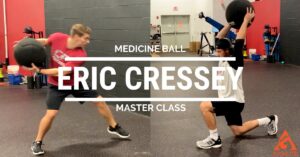
Random Thoughts on Sports Performance Training – Installment 37
This edition random thoughts from around the field of health and human performance is long overdue. Because of this week’s sale on my Medicine Ball Master Class, we’re going to hone in on medicine ball work.
1. Above all else, medicine ball work is awesome because of the crazy frequency at which it can be trained.
One of the overlooked features of medicine ball work is that it’s almost purely concentric in nature. Aside from a bit of quick preloading, there isn’t a ton of deceleration work involved – and that means it’s extremely rare for athletes to be sore after participating in medicine ball drills. To that end, you can train rotational power very frequently and athletes won’t feel banged up.
In many ways, this parallels what you see with tennis players, baseball players, soccer players, and football quarterbacks, and a host of other rotational sport athletes. They can participate in high velocity rotation almost every day and not break down. All we’re doing with medicine ball work is moving a bit further up on the force side and down on the velocity side of the force-velocity curve – and that probably actually makes it safer.
2. If the technique looks terrible, the first step is to lighten the weight of the medicine ball.
Let’s get this out of the way: throwing medicine balls isn’t lifting weights. You don’t get bonus points for going heavier; rather, the intent is to move a given load as fast as possible to optimize power output. For most folks, in the context of rotational power work, the appropriate load is 4-8lb. Very rarely will you see someone throw a 10- or 12-pound medicine ball really fast. The reason is simple: gravity creates a vertical path for the resistance (up/down), while we’re trying to project the ball horizontally (this is one key advantage of Proteus, but that’s a conversation for another day).
Beyond just the plane/load mismatch, you’ll often see athletes’ technique falter when the load gets heavier. Rotationally, the head often dives in front of the body as the center of mass is projected away from the load (and outside the base of support) as a way to counterbalance the load of the medicine ball. This prevents us from staying back (“head behind the belly button”), which is key for us to work into the front hip. If the head has already drifted too far forward, front hip pull-back can’t take place.
In overhead stomp variations, you can typically work much heavier with medicine balls without compensations – especially with bilateral variations. Once a staggered or split stance goes into place, though, athletes will often “run away” from the med ball: they laterally flex the spine away from the medicine ball. In doing so, they make it impossible to work into the front hip.
3. Experiment with “layering” your medicine ball drills.
An approach I’ve used more in the past year is “layering” medicine ball drills. Essentially, you transition from basic to advanced over the course of a few sets. Each progression builds on the key competencies fine-tuned in the previous sets. In this video example, the progression is:
1️⃣ Rotational Med Ball Scoop Toss
2️⃣ Shuffle to Rotational Med Ball Scoop Toss
3️⃣ Change of Direction to Shuffle to Rotational Med Ball Scoop Toss
4️⃣ Double Play Rotational Med Ball Scoop Toss
The possibilities are endless as long as you know where to begin and where you’re trying to end up – and you appreciate which athletes are actually ready for the progressions. Additionally, you can improve them even more by working in fillers between sets to address whatever movement limitation is the bottleneck to their performance.
If you’re interested in digging in deeper on the topic of rotation, I would strongly encourage you to check out my new Medicine Ball Master Class. I created this new resource in collaboration with Athletes Acceleration and it includes over 50 exercise demonstration videos, as well as my rationale for including them. Just visit www.CresseyMedBall.com to learn more.




